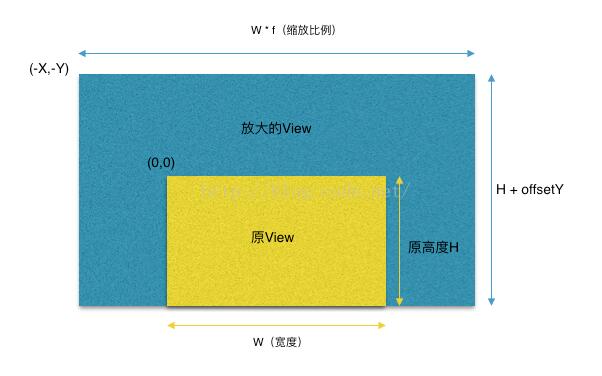iOS TableView头视图根据偏移量下拉缩放效果
导读:本文共2557字符,通常情况下阅读需要9分钟。同时您也可以点击右侧朗读,来听本文内容。按键盘←(左) →(右) 方向键可以翻页。
摘要: 本文实例为大家分享了iOS TableView实现下拉缩放效果的具体代码,供大家参考,具体内容如下在做项目时,一些TableView的地方会使用到下拉TableView让HeardView头视图随其偏移量的变化而变化,之前做过一次但没记录下来。现在做的时候总是遇到一些问题,比如下拉时是以原点向左右两边放大,这个只是效果问题。还有就是看到的视图确实变大了,但是... ...
目录
(为您整理了一些要点),点击可以直达。本文实例为大家分享了iOS TableView实现下拉缩放效果的具体代码,供大家参考,具体内容如下
在做项目时,一些TableView的地方会使用到下拉TableView让HeardView头视图随其偏移量的变化而变化,之前做过一次但没记录下来。现在做的时候总是遇到一些问题,比如下拉时是以原点向左右两边放大,这个只是效果问题。还有就是看到的视图确实变大了,但是会盖到下面的TableViewCell。开始以为是加在里面的视图变大,而TableViewHeardView没变大,我NSLog打印了一下两个视图的高度,发现是一样的,找不到问题了。
在网上找了一些相关的例子,各有各的做法,有的是根据偏移量来设置TableViewHeardView的缩放,有的是设置里面被我们设置为TableViewHeardView的那个视图的大小,都试了一下感觉还是不行,感觉缩放效果是有了的,但是拉大一点就会把下面的cell盖住。
之后自己摸索,调整后,我是用偏移量来控制里面的imageView的大小,imageView是我设置的HeardView的子视图,而heardView和TableViewheard的大小不会根据imageView变化,只是坐标变了,其实这是一种错觉,真实的效果是imageView坐标向左上方偏移,大小也变化,而heardView和TableViewheard没变大,但imageView变大的部分盖住他们的上方,让我们觉得heardView和TableViewheard也变大了,可以参考文章下面的逻辑图。
先看一看效果吧,一张是没下拉时的效果,一张是下拉时的效果。

可以看到imageView向四周变大了,而头像和昵称只是垂直方向位置变了,而大小没变。
这里用到的控件入下图

#define ScreenWidth [UIScreen mainScreen].bounds.size.width
在viewDidLoad里创建一下
//========== 头视图创建与设置 =========== imageHight = 250; [self creatHeardView];- (void)creatHeardView{ headerView = [[UIView alloc] initWithFrame:(CGRectMake(0, 0, ScreenWidth, imageHight+50))]; //背景视图 heardImageView = [[UIImageView alloc] init]; heardImageView.frame = CGRectMake(0, 0, ScreenWidth, imageHight); heardImageView.image = [UIImage imageNamed:@"backGround.jpg"]; [headerView addSubview:heardImageView]; //用户头像 personImageView = [[UIImageView alloc] initWithFrame:CGRectMake(ScreenWidth-30-60, imageHight-30, 60, 60)]; personImageView.layer.cornerRadius = CGRectGetWidth(personImageView.frame)/2; personImageView.layer.masksToBounds = YES; [headerView addSubview:personImageView]; //用户名 personNameLabel = [[UILabel alloc] initWithFrame:CGRectMake(CGRectGetMinX(personImageView.frame)-200, CGRectGetMinY(personImageView.frame), 180, 30)]; personNameLabel.font = [UIFont systemFontOfSize:15]; personNameLabel.textColor = [UIColor whiteColor]; personNameLabel.textAlignment = NSTextAlignmentRight; [headerView addSubview:personNameLabel]; //个人签名 introduceLabel = [[UILabel alloc] initWithFrame:CGRectMake(30, CGRectGetMaxY(personImageView.frame), ScreenWidth-60, 20)]; introduceLabel.font = [UIFont systemFontOfSize:10]; introduceLabel.textColor = [UIColor grayColor]; introduceLabel.textAlignment = NSTextAlignmentRight; [headerView addSubview:introduceLabel]; comTableView.tableHeaderView = headerView;//设置头视图}然后在TableView的滚动代理中有一个方法可以实时监测滚动偏移量,#pragma mark - 滚动代理- (void)scrollViewDidScroll:(UIScrollView *)scrollView{ CGFloat width = self.view.frame.size.width; // 图片宽度 CGFloat yOffset = scrollView.contentOffset.y; // 偏移的y值,还要考虑导航栏的64哦 if (yOffset < 0) {//向下拉是负值,向上是正 CGFloat totalOffset = imageHight + ABS(yOffset); CGFloat f = totalOffset / imageHight;//缩放比例 //拉伸后的图片的frame应该是同比例缩放。 heardImageView.frame = CGRectMake(- (width * f - width) / 2, yOffset, width * f, totalOffset); }}逻辑图:

这样TableView的下拉缩放头视图功能就可以实现了。
以上就是本文的全部内容,希望对大家的学习有所帮助,也希望大家多多支持。
</div> <div class="zixun-tj-product adv-bottom"></div> </div> </div> <div class="prve-next-news">iOS TableView头视图根据偏移量下拉缩放效果的详细内容,希望对您有所帮助,信息来源于网络。